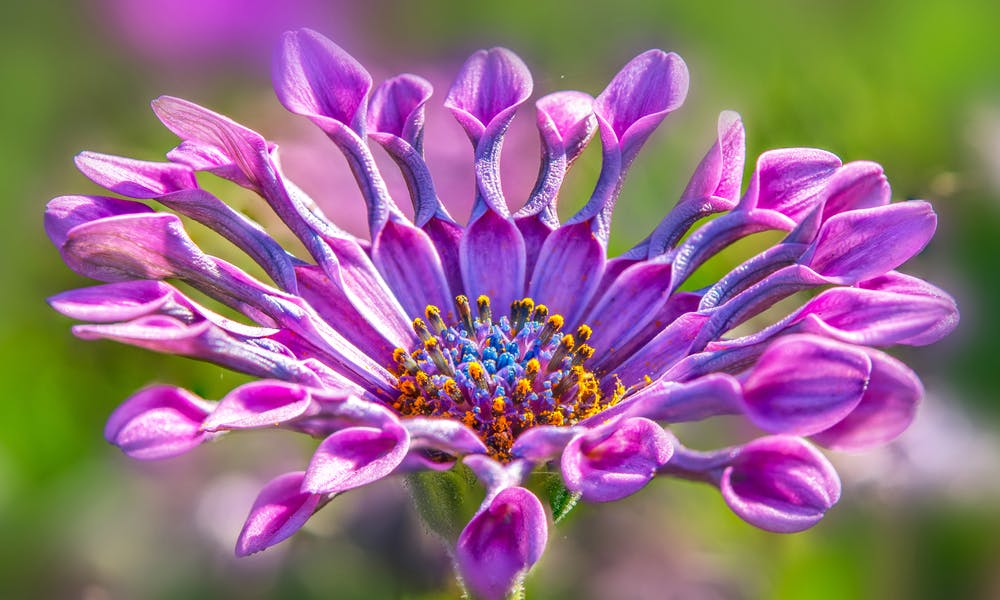Most of the population spend a large part of their time in a city surrounded by buildings, industries, and noise. We lack some nature in our daily life; some calm, and appeasing feelings. Therefore, we use the amazing power of flowers to achieve that. They enlighten our lives, give us hope and help us share our feelings of love and friendship.
Among the many types of flowers, there is the African daisy known by its beautiful and multiple colors. The curious daisy unfolds in the sun and closes when the light disappears. The most astonishing variety of African daisies is paradoxically the most common.
Some varieties have strange petals, ending in a spatula. Others are tinged with pink such as Osteospermum jucundum, or with buttery yellow, the aptly named the buttermilk!
In this article, we are going to talk about the following questions:
* Interesting Facts about the Daisy
* How to Cultivate the African Daisy?
* Maintenance of the African Daisy
* What Does the African Daisy Stand For?
* The Meaning of the Daisy Through Different Cultures.
Interesting Facts about the Daisy
African daisy belongs to the Asteraceae family. It is an essential plant for the southern regions or any other region with strong sunshine. These little rustic perennials in shimmering colors are not only beautiful by their flowering, but also by the magnificent velvety gray foliage, which wonderfully enhances their flowering.
A single daisy is made of two separate flowers. The central petals are a flower surrounded by rays of another flower. Daisies grow year-round. They are naturally resistant to plenty of flower diseases and many insects. This makes them perfect plants if you are a rookie and want to start a new garden. African daisy has significant botanical characteristics. In addition, the daisy leaves are edible; therefore, some people add them to their salads.
How to Cultivate the African Daisy?
African daisy is easy to grow. It is tolerant of the type of soil; however, you need to avoid planting them in excessively moist soil, which never dries. This causes the roots to decompose. Conversely, the hybrid daisy, once well rooted, supports drought. If you want to ensure a beautiful flowering, regular and wise watering is advised. When planting your flower in the ground or a pot, make sure that it no longer freezes.
On the other hand, one of the criteria for the success of this culture is sunshine. This daisy requires several hours of direct sunlight exposure per day. The flowers bloom under the sun’s rays and close each evening, which is quite extraordinary! They find it hard to thrive completely in cloudy weather. Flowering generally starts in May. It is particularly generous until the end of June. If you want to further optimize flowering, you can add flower fertilizer every 15 days.
Maintenance of the African Daisy
The flower needs to be in sunny exposure and well-draining soil. It grows without any particular maintenance. Simply water it in case of high heat, even if it is known for surviving extreme weather. You should remove faded flowers as the season progresses to help stimulate its generous flowering.
If the summer is humid and not very sunny, move the plant undercover. As a last resort, a spray of the Bordeaux mixture can slow down the damage of the fungus. In autumn, you must protect the stump with a mulch of leaves or dig up a few feet and put them in winter break in a cold greenhouse. In pots, your resources are limited; this is why some contributions of liquid fertilizer rich in potash and phosphorus can be very welcome during the summer. You can also choose to place one or two cones of slow-release fertilizer.
What Does the African Daisy Stand For?
Symbols of purity, innocence, and loyal love, daisies are also synonymous with grandeur, fidelity, and good esteem, in the language of flowers. African daisy is special, as it can express great flattery such as “you are the cutest,” a message admired by anyone who receives them, both women and men. A bouquet of daisies can brighten up any table, and bring a cheerful, friendly effect.
It also stands for a new start, which is why you can find them in bouquets offered to recent mothers and children to wish them a good life. In addition, offering this specific type of daisies is a way of showing someone you love and care about them. The message of the daisy is ultimately a message of hope and renewal.
The Meaning of the Daisy Through Different Cultures
The name Osteospermum, commonly known as African daisy, has a Greek origin. It means that the seeds have bone consistency, probably due to the hardness of their seed. In English, the word “daisy” comes from an old term that means”eye of the day” because these flowers only open during the day. In modern religion, daisies symbolize the sun because of their shape as a star. However, in Victorian times, multiple types of daisies stand for different things. The daisy of Saint Michael symbolizes a goodbye or departure. Gerbera daisies symbolize merriment.
African daisy, or osteospermum, is an annual plant cultivated for flowers with colored rays that attract butterflies. They are planted in full sun, in ordinary, cool and well-drained soil. Flowering, from June to September, produces pink, purple, yellow, red, orange or white flowers with a darker heart that grows at the end of small stems.
It is cultivated in pots, in the garden, flowerbeds, and borders. The medium green foliage is made of unevenly toothed leaves. There are several cultivars and hybrids like pink whirls with pinches in the shape of spoons.
You can buy them in containers in the spring or sow the seeds indoors 12 weeks before the end of the frost to transplant them into your garden.
